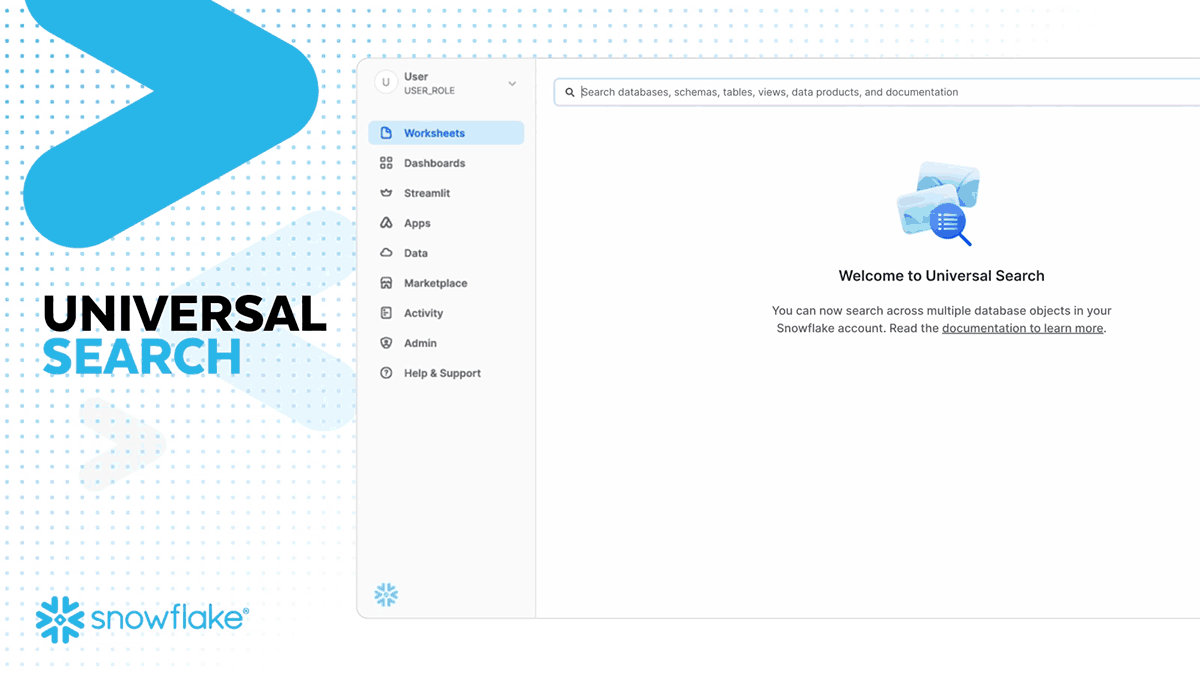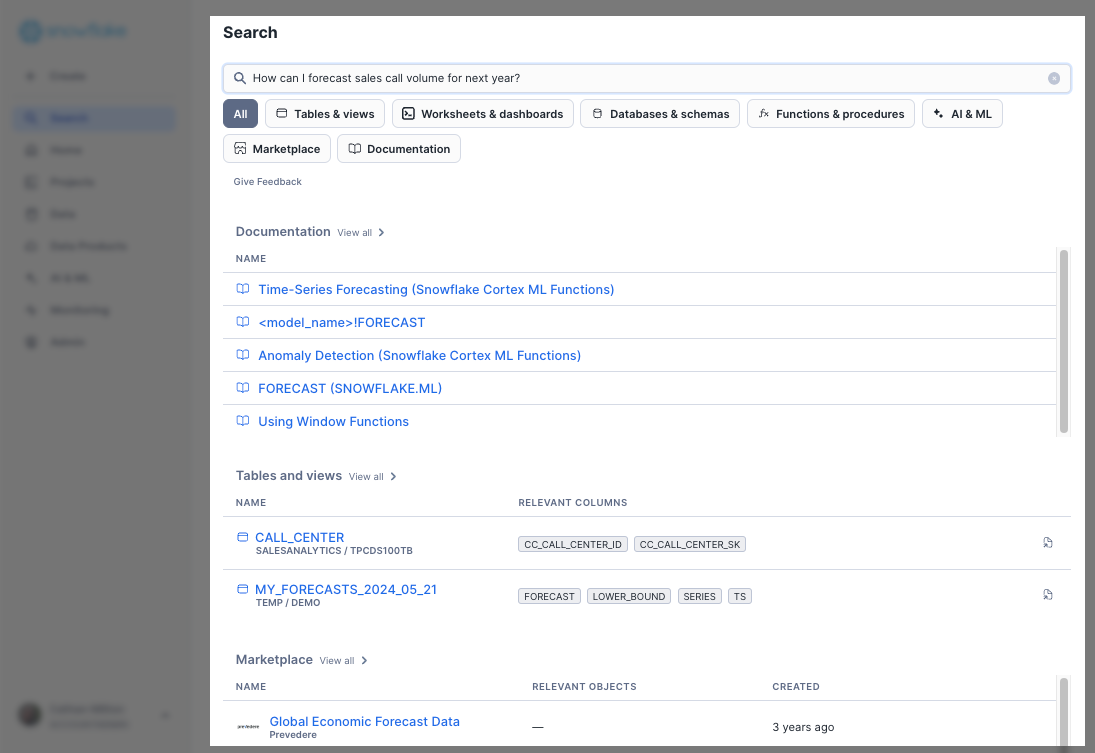Searching for data manually in Snowflake can be very challenging, time-consuming and sometimes frustrating. Snowflake identifies these problems and has developed Universal Search to change the way we search for data.
The universal search, built on a powerful snowflake cortex, is designed to make finding data straightforward. You can quickly and easily find data objects in your accounts and locate various Snowflake artefacts, like tables, views, databases, schemas, and data products, available in the Snowflake Marketplace.
Now, let us explore the world of Universal Search together, how it works, and why it’s a game-changer for data teams everywhere.
Table of Contents
What is Snowflake Universal Search?
Snowflake Universal Search is a powerful tool within the Snowflake world. It is similar to the Google search engine but just for data lovers and the data world. It enables you to find and manage databases, tables, views, functions, stored procedures, data products, documentation, and other resources across the Snowflake environment quickly.

Key Functionalities and Features of Snowflake Universal Search
- Comprehensive Search Capabilities: It can find anything from data types to documentation.
- Real-Time Indexing and Updates: With the universal search, you will always get up-to-date and accurate search results.
- Advanced Filtering and Query Options: You can use the universal search to refine your search with filters like schema, creation date or object type,
- User-Friendly Interface and Dashboards: The universal search interface is super easy to explore and use to search for results.
Benefits of Using Snowflake Universal Search
- Improved Data Discovery and Management: With universal search, you can find what you need faster, without writing complex SQL queries.
- Boosted User Productivity: Spend little or no time searching and more time exploring your data.
- Enhanced Collaboration: You can easily share data and insights with your team.
- Improved Data Governance: Quickly locate sensitive data and enforce compliance.
Hevo is the only real-time ELT No-code Data Pipeline platform that cost-effectively automates data pipelines that are flexible to your needs. With integration with 150+ Data Sources (60+ free sources), we help you not only export data from sources & load data to the destinations but also transform & enrich your data, & make it analysis-ready.
Here’s why you should explore Hevo:
- Quick Setup: Hevo can be set up in minutes with minimal learning required.
- No Coding Needed: Enables data loading without writing any code.
- No Performance Compromise: Load data efficiently without sacrificing performance.
- Wide Integration: Supports numerous sources, allowing flexibility in data types.
Technical Breakdown of Snowflake Universal Search
A lot of advanced technologies were used in designing the Snowflake universal search to provide a user-friendly and effective data discovery experience.
The breakdown of its key components is detailed below.
Main Components
- Natural Language Processing (NLP): The snowflake universal search uses NLP to recognise and read complex and ambiguous queries.
- Semantic Search: The universal search can process and deliver more useful search results, even when there is a mismatch between the query term and object name by understanding the semantic meaning of words and phrases.
- Vector Search: Often, snowflake uses vector search techniques to represent data objects and user queries as numerical vectors. This technique allows for efficient similarity ranking and matching of search results.
- Search Engine and Indexing Technology: Snowflake uses both inverted indexes and other search engine technologies to optimise query performance. This indexing mechanism is critical for fast and accurate search results.
- Snowflake Metadata Integration: The Universal Search integrates with Snowflake’s metadata repository to access information about databases, tables, views, functions, and other objects.
- Integration: Seamless Integration with Existing Snowflake Environments: Snowflake Universal Search can be integrated easily into your existing Snowflake environment. It works with any existing data structures and it doesn’t require a complicated setup. Furthermore, it can be used with so many third-party tools and platforms, making it a flexible and versatile solution for your data stack.
How Snowflake Universal Search Works
Technical Overview
Snowflake Universal Search uses advanced indexing and search algorithms to understand your queries and deliver accurate search results. It is like having a very smart assistant who knows your data and can help you find exactly what you are looking for.
- Query Processing: The universal search uses NLP techniques to understand the idea behind a query any time a user enters a query
- Index Lookup: According to the query’s keywords and semantics, the search refers to its index to retrieve relevant data objects
- Ranking and Scoring: Freshness, popularity, and relevance are some of the factors that are considered when search results are ranked.
- Result Presentation: The search results are shown to the user in a user-friendly format, often with additional information like object descriptions and metadata.
Use Cases and Examples
- Data Governance: This can be used to locate and manage sensitive data for compliance and auditing quickly.
- Business Intelligence: You can access all of your data for analysis and reporting.
- Data Engineering: You can also use universal search to streamline your data pipeline management by efficiently finding data sources and assets.
Steps to Set up Universal Search
Before you can set up a universal search, you must have a Snowflake account with the appropriate permissions.
Steps:
- Access Snowflake: Sign in to your Snowflake account.
- Search-Bar Navigation: Locate the search bar at the top of the screen in the Snowflake interface.
- Start Searching: Type your search query into the search bar. For Instance, you can type “product table” or “Collection report.”
- Explore Results: The Universal Search will show results grouped by different types of objects (databases, tables, views). Explore detailed results by clicking on the desired prompt.

Tips for Optimizing Search Results
- Use Detailed Search Terms: For better query results, always use detailed and specific search queries.
- Leverage Filters: Always consider using the available filter to refine your search based on object type or schema
- Advanced Features: Look for advanced search options or settings that might be available in your Snowflake environment.
- Regularly Update Indexes: Make sure your search indexes are always up to date.
- Leverage Dashboards: Use user-friendly dashboards for efficient data management.

Limitations of Snowflake Universal Search
Although Universal Search is a powerful tool, it is important to be conscious of its limitations.
- Potential Performance Impacts with Large Datasets: Searching large datasets may impact the performance and speed of the universal search.
- Limitations in Search Customization: Highly customized searches might require additional configurations.
- Possible Integration Challenges with Non-Standard Data Sources: Integrating universal search with unconventional data sources might require additional configuration.
Comparing Snowflake Universal Search with Other Data Discovery Tools
The Snowflake Universal Search stands out compared to other data search tools due to its deep integration with the Snowflake environment, providing a unified search experience across all your data assets.
Key Differences and Advantages
| S/N | Feature/Tool | Snowflake | ElasticSearch | AWS Glue Data Catalog |
| 1 | Unified Data Platform | Yes | No | No |
| 2 | Scalability | Independent storage/compute | Limited | Managed by AWS |
| 3 | Data Sharing | Built-in, secure | No | No |
| 4 | Zero Maintenance | Yes | No | No |
| 5 | Semi-Structured Data | Native support | No | No |
| 6 | Integrated Data Marketplace | Yes | No | No |
| 7 | Security Features | Robust | Limited | AWS-based |
| 8 | ML and BI Integration | Advanced | No | Limited |
| 9 | Automatic Optimization | Yes | No | No |
| 10 | User-Friendly Interface | Yes | CLI-based | Limited |
Why Choose Snowflake’s Solution?
Snowflake Universal Search offers unparalleled integration with Snowflake’s data platform, making it the optimal choice for organizations already utilizing Snowflake for their data needs.
Case Studies and Real-world Applications
A lot of data-driven organizations are already aware of the capabilities of the universal search tool as its impact is already been felt. Here below, are some of the potential real-world applications and case studies
Scenario 1: Streamlining Data Discovery for Analysts
- Problem: A utility company with a complex and large data ecosystem, makes it difficult for engineers and analysts to find the data they need for their tasks.
- Solution: Snowflake Universal Search is implemented. Analysts can use NLP queries to quickly locate useful tables, views, and data products, saving valuable time and effort.
- Impact: Data Users become more productive. hence, spending less time searching and more time developing data products and valuable insights
Scenario 2: Enhancing Collaboration and Knowledge Sharing
- Problem: A large financial service company with several teams working on different data projects, leading to silos and duplicated efforts.
- Solution: Universal Search is used to improve data discoverability. Team members can easily find useful data and documentation, facilitating collaboration and knowledge sharing.
- Impact: Teams work more efficiently, avoiding redundant data exploration and ensuring alignment with existing initiatives.
Scenario 3: Accelerating Data Governance and Compliance
- Problem: A retail company needs to ensure compliance with data regulations, but manually searching for sensitive data proves time-consuming and inefficient.
- Solution: Universal Search is used to locate sensitive data objects quickly. This facilitates data governance efforts and helps ensure data compliance.
- Impact: The company can meet data security and privacy regulations more effectively, minimizing compliance risks.
Conclusion
Snowflake Universal Search is a powerful tool that enhances data discovery and management within the Snowflake environment. Its comprehensive search capabilities, real-time indexing, and user-friendly interface make it an invaluable addition to any data-driven organization.
While Universal Search is a powerful tool, it’s essential to be aware of its limitations. For instance, searching extremely large datasets might impact performance. Additionally, highly customized search requirements might necessitate additional configurations.
To overcome these challenges and maximize the potential of Snowflake Universal Search, consider integrating Hevo Data into your data management strategy. Hevo offers seamless, real-time data integration that ensures your Snowflake environment remains optimized for performance and usability. With Hevo, you can easily connect all your data sources, enabling smoother data flows and enhanced search capabilities.
Frequently Asked Questions on Snowflake Universal Search
1. How does Snowflake search optimization work?
Snowflake search optimization works by using its Universal Search feature, which indexes metadata in real-time, allowing users to quickly find tables, views, and columns across their Snowflake environment. This feature leverages advanced indexing and search algorithms to enhance data discovery and streamline query performance.
2. Does Snowflake have Boolean data type?
Yes, Snowflake supports the Boolean data type.
3. How do you search for objects in Snowflake?
In Snowflake, you can search for objects (like tables, views, or schemas) using the SHOW commands, such as SHOW TABLES or SHOW SCHEMAS. You can also query the INFORMATION_SCHEMA views, like INFORMATION_SCHEMA.TABLES, to filter and find specific objects based on criteria like name or type.
4. How do you search for fields in Snowflake?
To search for fields (columns) in Snowflake, you can query the INFORMATION_SCHEMA.COLUMNS view. For example, use SELECT * FROM INFORMATION_SCHEMA.COLUMNS WHERE TABLE_NAME = ‘your_table_name’ to retrieve columns for a specific table, filtering by criteria like column name or data type.








